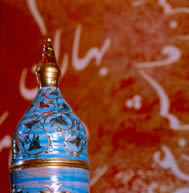




 |
    |
Exhibitions |
||
 |
Objects of desireAt first sight this would seem to be an exhibition simply about contrasts; Shan Egerton's austere, dark-toned pastels of the humblest of everyday objects - Romanian pottery fruit containers, Indian cooking vessels, time-worn ritual objects on the one hand, Carolinda Tolstoy's evanescent, richly painted and exotically Orientalist faiences summoning up images of the courtly and extravagant on the other. Yet, the more you look at them alongside each other, the more you are struck by what it is they share in common, most particularly their belief in the power of the objects they paint and make to evoke the most powerful of human associations - "the miracle of things" as the Goncourt Brothers wrote of Chardin - and, like Chardin, even when there are no figures depicted, there is always the strongest suggestion of human presence in them. Thus in Shan Egerton's pastels of ritual objects we sense the marks and patina of literally thousands of touching hands over decades perhaps even centuries of spiritual use, while in her fruit bowls and cooking vessels the very texture of the pastel itself conjures up the smells and sensuality of the daily rituals of food and social communion. And it is, for me at least, the actual forms that Carolinda Tolstoy's work takes, the great storage jars, vases and salt kiln, with their implications of human usage and usefulness, which gives to the shimmering colour and dream-like arabesques of brush-stroke that connection back into the exhilaratingly human. Technically too, both artists are quite masterly, though here perhaps the contrasts, Shan's unassuming earthy, Carolinda's extrovert bold, full of air and movement. Yet even here again, they both recognise the same essential truths of their art, that out of those quiet, waited for encounters between history and spirit can come those moments we call art. Nicholas Usherwood |
 |
| © Carolinda Tolstoy 1999-2018 | Web site design: QuincDigital |